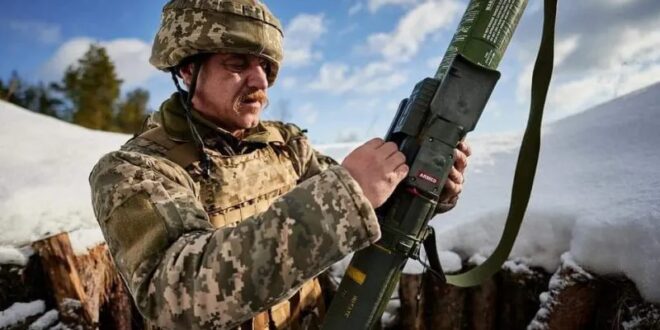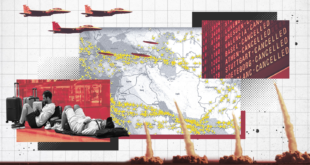Washington Must Ramp Up Support for Vulnerable Partners—Before It’s Too Late
It is too soon to predict how Russia’s brutal, unjustified war against Ukraine will end. But for now, it is clear that the Russian military has shockingly underperformed in the first phase of the war, whereas the Ukrainian military has punched far above its weight. Other revisionist powers contemplating aggression will be looking closely at Russia’s failings to avoid making the same mistakes, and the countries they threaten will be looking to Ukraine’s example for insight into how to fend off a larger, better-equipped adversary.
But there are also lessons for the United States. U.S. defense leaders need to consider what outcomes in Ukraine mean not only for how Washington assesses the military capabilities of adversaries in the future but also for how the United States and its allies can use asymmetric tactics to undermine those adversaries’ strengths and exploit their weaknesses. For example, militaries fielded under leaders who do not tolerate dissent or question assumptions will be vulnerable to a host of problems, from strategic miscalculation and inadequate logistics to poor battlefield command and troop morale. This is a systemic weakness of authoritarian regimes, but other states can also be susceptible. In addition, militaries that have not been tested in battle may struggle to train troops for the actual conditions they will face in war, to fight effectively as a joint force, and to adapt in real time to an adversary’s asymmetric tactics.
Moscow’s war effort has been deeply flawed, but that is not the only reason Ukrainian forces have fared so well: they have been able to take advantage of Russian weaknesses thanks in part to the help they have received from the West. The remarkable performance of Ukraine’s military is a direct result of a multiyear security-assistance effort undertaken by the United States and its NATO allies since Russia’s 2014 invasion of Crimea. In those eight years, support in the form of equipment, training, and help with planning transformed the Ukrainian military into a far more capable fighting force. Over the past three months, unified Western assistance has made a difference on the battlefield, too. Dozens of countries have come together to share intelligence, offer military and economic aid, and impose severe economic and political costs on Russia.
In Ukraine, Washington now has a working model for strengthening the ability of its allies and partners to defend themselves and, possibly, to deter future conflict. It should not wait until another powerful nation menaces a smaller neighbor to act on the lessons from this war.
WHERE RUSSIA WENT WRONG
Russia has made many missteps before and since the February invasion, and zeroing in on the sources of these problems provides clues to avoiding or overcoming them. Moscow and other would-be aggressors will learn from these failures, and so should Washington, taking note of the ways in which the next country to launch a war of aggression might seek to improve on Russia’s performance in Ukraine.
Many of Russia’s errors stem from the leadership climate in the Kremlin. Authoritarian leaders do not tolerate dissent or unwelcome news, and Russian President Vladimir Putin is no exception. As was apparent in his televised meeting with his top national security advisers prior to the invasion of Ukraine, Putin has created a climate in which subordinates fear contradicting or even questioning his worldview. Speaking truth to Putin is a recipe for public humiliation, dismissal, or worse. In the context of war, the result is that leaders do not stress-test their assumptions and that they adapt far too slowly when their plans do not survive contact with reality. Putin’s initial belief that the Russian military had overwhelming superiority and that the Ukrainians lacked the will and ability to fight quickly proved false, but the Kremlin did not adjust its approach. Instead, Putin’s toxic leadership and brittle decision-making process set the conditions for the failed drive to take Kyiv.
The intolerance of dissent and debate is a hallmark of authoritarian systems, but democracies are by no means immune to the problem. In the United States, faulty assumptions and poor planning bedeviled the 2003 U.S. invasion of Iraq. Creating a leadership climate in which dissent is not only tolerated but also solicited as plans develop dramatically improves the chances of successful outcomes.
Ukraine has been able to exploit Russian weaknesses thanks in part to the help it received from the West.
There is a saying among military professionals often attributed to Omar Bradley, the American general who served as chairman of the Joint Chiefs of Staff after World War II: “Amateurs talk strategy. Professionals study logistics.” Russia’s military logistics in this war have been wholly inadequate. The Ukrainians exploited this shortcoming, sabotaging forward units and poorly defended supply lines as the Russian army attempted to reach Kyiv over land. Moscow’s forces quickly ran out of fuel, food, and other basic supplies. Was this failure to provide logistical support and operational security to the invasion forces a consequence of inadequate planning? Did graft and corruption siphon resources away? Was it sheer incompetence? Probably all of the above. Russia’s shortcomings in this area and its inability to adapt under attack have revealed a critical vulnerability that Ukrainian forces should continue to exploit. Its failure also serves as a warning for any future aggressor that seeks to project power across long distances or contested terrain.
Another surprise has been the failure of the Russian air force to gain control of Ukraine’s skies or successfully conduct joint operations with troops on the ground, despite having a larger fleet than Ukraine. Ukrainian forces have shot down an estimated 172 Russian aircraft in the first two months of the war alone. Russian pilots are limited by the fact that they have few long-range precision-guided missiles in their inventory, which means they must often operate within the reach of Ukrainian antiaircraft weapons. To date, the Russian air force has primarily conducted deliberate strikes on military and civilian targets (the latter contributing to charges of war crimes), while providing little to no close air support for ground forces in combat. Without reconnaissance and strike craft in the air, soldiers are left far more vulnerable and less effective.
Russian forces also appeared to be inadequately trained for the type of operations they have been asked to execute. Ground forces were unprepared for the intensive block-to-block fighting that is the hallmark of urban warfare. Nor were they ready to face a Ukrainian adversary schooled in asymmetric tactics, ready to sabotage invading forces by puncturing the gas tanks of idling tanks and armored vehicles at night or launching small-unit ambushes to take out senior Russian military commanders and their communication networks.
Finally, the Russian military’s poor performance and rampant commission of war crimes is a testament to the poor quality of its leadership. Professional ethos is critical on the battlefield. But Russia lacks a professional noncommissioned officer corps, it relies on conscripts with little training and low morale, and it blatantly disregards international law and military ethics.
Together, these errors add up to a broader failure at the strategic level. Putin’s miscalculation is bringing about the very future he feared: a more united and resolute transatlantic alliance, Finland and Sweden clamoring to join NATO, a fortified NATO military posture on Russia’s periphery, and a commitment to increased defense spending by previously reluctant European member states. The result is a stronger, reinvigorated NATO and a weaker, more isolated Russia.
HOW UKRAINE TOOK ADVANTAGE
By contrast, the performance of the Ukrainian military in this conflict thus far has surpassed expectations. This is not the same military that could not prevent Russian forces from occupying Crimea in 2014. What changed?
First, in the years since Russia’s illegal annexation of Crimea, Ukraine focused on becoming, as General Tony Thomas, former commander of U.S. Special Operations Command, once put it, more like “a porcupine,” indigestible to the Russian bear. With the help of the United States and other NATO members, Ukraine undertook a concerted effort to train and equip its forces to better impede and repel a Russian invasion. In the process, the Ukrainian military became more agile and innovative. It has mastered the use of the Javelin missile system and small drones to take out Russian tanks, as well as Stinger and other surface-to-air missiles to shoot down Russian aircraft. And it has learned how to conduct highly effective sabotage operations under the cover of darkness. Ukraine’s investment in reorienting its force for asymmetric warfare is paying large dividends in the current conflict. Now, the United States and its allies can study the Ukraine case to replicate the sustained training and advising, the focus on new operational concepts, and the alignment of means with desired outcomes that make it possible for security assistance to have an outsized impact.
Washington should not wait to act on the lessons from this war.
Since 2014, the United States and other Western countries have also been supplying Ukraine with military equipment that is more sophisticated and more lethal than what it possessed before. The United States provided more than $2.5 billion in military aid during this period. Many argued this was not enough in terms of either quantity or quality. But Western partners have made up for much of this shortfall with a dramatically increased supply of essential military equipment since February. The United States alone has sent Ukraine more than $3 billion in military aid, including 1,400 Stinger antiaircraft missiles and 5,100 Javelin antitank missiles, along with Mi-17 helicopters, patrol boats, counterartillery and counterdrone tracking radar systems, armor, guns, helmets, grenade, C-4 explosives, and coastal defense vessels. Canada, Germany, the United Kingdom, and other countries have provided weapons and supplies worth hundreds of millions of dollars. This veritable flood of military equipment over the past three months has been possible because Ukraine shares a land border with NATO countries far from its border with Russia. The gift of favorable geography may not be present in future conflicts, so proactive security assistance will be imperative to avoid a situation where the United States and its allies are scrambling to fill gaps after a crisis erupts.
Just as important as the equipment itself is how Ukraine has used it. For example, military historians may look back on this war as a turning point in the use of drones on the battlefield, as thousands of reconnaissance and lethal unmanned aircraft spread out over the skies of Ukraine, taking on armored targets at a fraction of the cost of conventional systems. But the United States and its allies could have made an even more concerted effort to prepare Ukrainian defense forces for this war. Some countries’ hesitation to provide lethal assistance to Kyiv before Russia’s invasion meant that Ukrainian forces have had to receive crash courses on how to operate new equipment mere days or hours before using it in battle. This is obviously not ideal, and such last-minute instruction may not be possible in future conflicts. Vital training must therefore happen long before they occur.
Ukraine has also benefited from its existential interest in winning this war and the greater resolve that comes with it. There is no stronger motivation to fight than defending one’s family, home, and country. Many Russian soldiers, meanwhile, do not understand why Russia went to war in the first place; some have family and cultural ties to Ukraine. This disparity in resolve manifests on the battlefield. It is not surprising that even hardened fighters from the Wagner Group—Russian mercenaries notorious for their brutal tactics in Libya and Syria—have, according to media reports, refused to serve in Ukraine. And the readiness of the Ukrainian people to resist Russia’s aggression has inspired the kinds of international support that yield tangible benefits, from security assistance and military equipment to economic and humanitarian aid and substantial sanctions against Russia. The will to fight matters, in more ways than one.
THE COALITION BEHIND KYIV
The United States’ and its allies’ contributions to Ukraine’s success so far offer a template that can be applied to future conflicts. Of particular note is the Biden administration’s unprecedented use of intelligence. The rapid declassification of information early in the crisis to combat Russian propaganda with hard facts denied Putin the ability to set a false narrative and manufacture a justification for war. By sharing intelligence with partners, Washington had an easier time bringing together a large and effective international coalition, since its allies and partners were able to develop a common assessment of the threat. And, if media reports that the United States has provided intelligence to Ukrainian forces are true, Washington has undoubtedly enhanced their effectiveness on the battlefield, enabling them to thwart Russian advances and target Russian force concentrations.
Beyond intelligence sharing, the Biden administration’s extensive consultation with allies and partners has paid off in the initial response to the Russian invasion. A high degree of collaboration at both the logistical and the policy levels has enabled remarkable transatlantic unity behind tightening sanctions and a well-coordinated flow of military equipment to fill critical gaps in Ukraine’s arsenal, from Russian-made air-defense systems provided by eastern European nations to artillery, mortars, ammunition, antiship missiles, armed drones, and armored vehicles from others. The synchronized use of multiple supply lines from frontline NATO countries into Ukraine has made it possible to deploy new equipment in record time. For all its success, the surge in military aid to Ukraine has also revealed vulnerabilities in the U.S. defense industrial base—stocks of Stinger antiaircraft missiles, for example, have been significantly depleted, and replacing them will take time. Washington will need to shore up the weak links, but on the whole, it can treat the Ukraine case as a model of close coordination working well.
What is most important is that the United States and its allies have maintained their robust support for Ukraine without triggering a broader war between Russia and NATO. As Russian leaders engage in nuclear saber rattling, the U.S. response has been calm and deliberate. The United States and NATO have walked a careful line when it comes to military involvement, rejecting proposals for a no-fly zone to avoid putting their personnel in direct contact with Russian forces while still reaffirming their commitment to defend “every inch” of NATO territory. Time will tell whether this balance is sustainable. If Russian forces appear headed for defeat and Putin employs chemical or tactical nuclear weapons to try to regain the initiative, or if Russia miscalculates and strikes supply lines inside NATO territory, such clear escalation will test the alliance’s measured posture.
THE NEXT WAR
If the United States and its allies and partners want to meaningfully strengthen their capacity to deter and defeat future attacks by Russia, China, and other authoritarian states, there is much they can learn from the war in Ukraine. Above all, the early trajectory of this crisis makes clear that Washington cannot and should not wait until conflict looms to start strengthening its own ability to prevent aggression and the ability of at-risk partners to defend themselves. Security assistance should be accelerated and focused on providing asymmetric capabilities that are not provocative on their own but instead turn vulnerable partners into “porcupines” that are difficult and costly to attack.
These lessons can most obviously be applied in the case of Taiwan, where Chinese leadership may contemplate future military action to conquer the island. Efforts to strengthen the U.S. deterrent posture in the Indo-Pacific should go hand in hand with helping Taipei strengthen a multilayered defense, from its maritime and air approaches to its cybersecurity and the security of its major cities. Washington should ramp up its provision of key defensive capabilities, including antiship missiles, sea mines, and air and missile defenses. It should also offer more training in insurgency and popular resistance, so that in the event of a Chinese attack, Taiwan could buy time for the international community to muster an effective response.
In Ukraine, Western countries were quickly able to mobilize and fill gaps with military aid after the Russian invasion began; they should not count on such favorable conditions in other conflicts. As the rest of this war plays out, the United States and its partners should be thinking carefully about how to deter and, if necessary, prevail in the next one. They can be sure that their adversaries will be learning their own lessons as well.
 Eurasia Press & News
Eurasia Press & News



